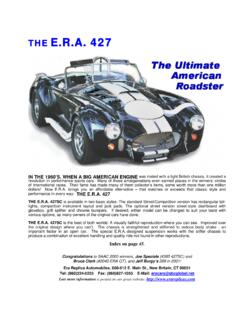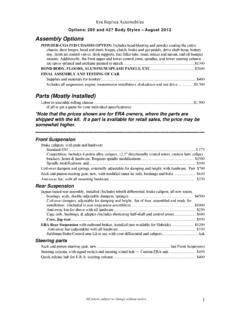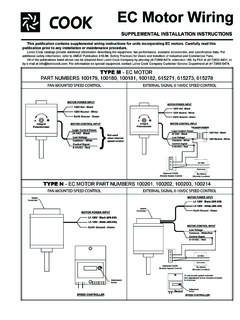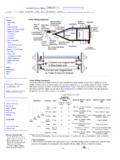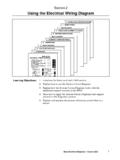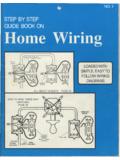Transcription of A SHORT PRIMER - erareplicas.com
1 ELECTRICITY AND wiring A SHORT PRIMER (Sorry!) *This guide is not finished, but I ve decided to release it as a work-in-progress because of its usefulness. This troubleshooting guide was created exclusively for owners of cars. Any reproduction of this guide without permission of is strictly forbidden, and will be punished by the perpetrator being forced to work on a kit. 2012, Era R eplicas Automobiles INTRODUCTION Even without any electrical experience, you needn t be afraid of working on an kit. The basic concepts of electricity are relatively easy to understand, and this guide will make troubleshooting a straightforward and logical process. Besides, compared with the latest in production car circuitry, the 427SC and GT have very simple electrical systems. built wiring harnesses have had very few functional flaws. We are unique in the industry in soldering all our connections to avoid the poor connections that inevitably result from water and salt.
2 The majority of problems encountered by builders of our kit have been caused by faulty switches, wiper motors, or other peripheral components. (And even, on rare occasion, incorrect connections by the kit builder.) This mini-textbook will help you locate and eliminate most of the glitches that you might experience during your "Automotive Experience". If you are electro-phobic or have limited knowledge of electricity, please read the General Concepts section. Even if you never have a problem with your car, acquiring a true understanding of what happens underneath the hood - or your roof - can be invaluable in real life. Knowledge is power! Although help is always available from us, please read the following information first. If you must call, use this guide to gather as much information as possible before the phone call. This will make finding the answer to your problem much faster.
3 Thanks! 3 The Shocking Truth! Everything You Ever Wanted To Know About Electricity, But Were Afraid To Ask BASIC CONCEPTS POWER, ENERGY, VOLTAGE, CURRENT (AMPERAGE) Power! We have come to expect things to happen when the switch is turned on. Motors, solenoids, coils, radios, etc. are all our slaves. A little electricity is all that is necessary. In automotive applications, electrical energy is carried by insulated copper wire to where it is needed. The source for this power is the battery an/or the alternator. Electric Current (I) is essentially a flow of electrons within the wire. In most automotive applications, this current flows continuously in one direction within the wire "conduit" and is called direct current (DC). Household current alternates direction 60 times a second (60 Hertz) in the USA, 50Hz most other places, and is called AC.
4 (Strictly speaking, it should be called alternating voltage.) But everything that follows pertains only to DC current. Current flows from Positive Negative By historical convention, current flows from positive to negative. Think of current (I) - amperage - as the rate of water flowing in a pipe, measured as gallons/hour. In reality, the electrons are flowing in the opposite direction, since their charge is negative. The analogous circuits of fluid and electricity are shown below. They each require a pump/generator or a energy storage source (battery/pressure accumulator). Both systems have energy draws in the circuit: Restrictions, motors, and storage areas. Resistance (R) is the amount of hindrance to the current that a component creates. Every component in a circuit has resistance, although some have practically zero. Impedance is resistance associated with energy stored in a magnetic field - an alternator, coil or motor.
5 It is the electrical equivalent of inertia and is proportional to the rate of change of current. Notice that these are both circuits. The stuff going out must equal the stuff going in. The obvious difference is that automotive electrical circuits are typically completed through a common ground rather than a dedicated return line. 4 Voltage (V) is equivalent to the amount of pressure in the pipe at any given point, and resistance (R) is the amount of restriction to the flow within the pipe. All the current that flows from the positive (+) sources must eventually go into the negative (-) sink which, in the case of a car, is called ground. Voltage is usually measured in relationship to ground, which is defined as being at 0 volts. Energy (in the form of heat) is released when current passes through any resistance, and Power is the rate of Energy released per unit time.
6 All wires have some resistance, superconductors notwithstanding, although the resistance is sometimes so low as generate negligible heat. The same thing happens when there is a restriction in a fluid carrying pipe. There is a voltage drop associated with this phenomenon: V=IxR. The power dissipated is = I2xR = VxI and is usually measured in watts (W). Note! In AC circuits, since the voltage and current are changing continuously from positive to negative, companies have invented something called peak power . Since it s calculated from the peak voltage, it inflates the amount of actual power absorbed over a full cycle. Incandescent lights work because electrical energy is transformed into the heat necessary to make the filament glow brightly. Any time there is a flow of electrons (current), a magnetic field is created surrounding the flow.
7 Mechanical energy in the form of force and/or motion is released by the magnetic fields in electric motors and solenoids. Starter and wiper convert this energy into rotary motion. Solenoids convert the energy to a linear direction. Starter solenoids, relays and some electrically operated valves operate by this principal. Induction is a phenomenon where energy is stored in a magnetic field generated by the current in a wire. The high voltage discharge of the ignition coil is an example of extracting large amounts of energy for a SHORT duration using this method of storage of energy. ELECTRICAL CIRCUITS All electrical components are in circuits, where all current flows from a source, through each component, into a sink. There are several ways that components are integrated into these circuits: SERIES CONNECTIONS All the current in a series connection must pass through all the loads in the series.
8 Consequently, there is a voltage drop across each load of V=I R where R is the resistance across the load. When more than one load exists in a parallel circuit, the total voltage drop still remains at battery voltage (assume 14 Volts for convenience here.) Vtot=14 Volts= V1+ V2+.. Since V=I R Each individual load has a voltage drop proportional to its resistance, but the current is decreased: I = 14 volts/(Sum of the Resistances) the sum of the individual voltage drops always adds up to 14. What this means to you If you have an extra resistance in a circuit, (perhaps in the form of a dirty connection or even an undersized wire) there will always be a voltage drop associated with that resistance. Don't forget, even copper wire has resistance. If the current is too high there will be a high voltage drop along the wire. Try starting your car with an 18 gage wire from the battery to the starter!
9 The wire will get very hot, and the starter will receive only 1 or 2 volts. Almost all the energy (V2/R) will be dissipated in the wire, not the starter. Bad connections can frequently be found by feeling for warm spots along the circuit. Bad battery connections can be found the same way. 5 PARALLEL CONNECTIONS Just about all circuits in an automobile are arranged in parallel. In theory each load sees the full 14 Volts supplied by the battery, and the total current draw is simply the sum of all the individual circuit currents. In practice, there are always hidden resistances from non-ideal connections and even from the internal resistance of the battery itself. These extra resistances seldom create more than 1 or 2 Volts drop unless load conditions are very high. "Ground" is the electrical equivalent to zero energy level (zero pressure level).
10 In an automobile, the chassis, engine and other passive surfaces usually act as ground. All current from the battery and alternator ultimately ends up going to ground. Sometimes current finds its way to ground through an unplanned path. This is what is known as a SHORT (circuit). See page 6. The switches in any electrical system are simply valves which stop or selectively channel the current to appropriate places. Some switches are simply on or off. The light switch, for example, first opens the "valve" to the parking lights, and then to the headlights. Other switches have variable internal resistance which is controlled by the knob. The rheostat for the dashboard lights is an example of this. A relay is just a switch controlled by electricity instead of mechanical control. Relays are used when high current makes a standard switch impractical, or a simple action must start a complicated process.

